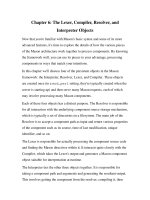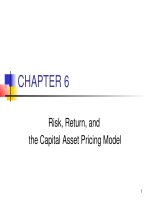Lecture Undergraduate econometrics - Chapter 6: The simple linear regression model
Bạn đang xem bản rút gọn của tài liệu. Xem và tải ngay bản đầy đủ của tài liệu tại đây (111.68 KB, 47 trang )
Chapter 6
The Simple Linear Regression Model: Reporting the Results and Choosing the
Functional Form
To complete the analysis of the simple linear regression model, in this chapter we will
consider
• How to measure the variation in yt explained by the model
• How to report the results of a regression analysis
• Some alternative functional forms that may be used to represent possible relationships
between yt and xt
Slide 6.1
Undergraduate Econometrics, 2nd Edition-Chapter 6
6.1
The Coefficient of Determination
Two major reasons for analyzing the model
yt = β1 + β2xt + et
(6.1.1)
are
1. to explain how the dependent variable (yt) changes as the independent variable (xt)
changes, and
2. to predict y0 given an x0.
• Closely allied with the prediction problem is the desire to use xt to explain as much of
the variation in the dependent variable yt as possible.
Slide 6.2
Undergraduate Econometrics, 2nd Edition-Chapter 6
• In Equation (6.1.1) we introduce the “explanatory” variable xt in hope that its variation
will “explain” the variation in yt.
• To develop a measure of the variation in yt that is explained by the model, we begin by
separating yt into its explainable and unexplainable components. We have assumed
that
yt = E(yt) + et
(6.1.2)
where E(yt) = β1 + β2xt is the explainable, “systematic” component of yt, and et is the
random, unsystematic, unexplainable noise component of yt.
• We can estimate the unknown parameters β1 and β2 and decompose the value of yt into
yt = y?t + et
(6.1.3)
Slide 6.3
Undergraduate Econometrics, 2nd Edition-Chapter 6
where y?t = b1 + b2 xt and et = yt − yt .
• In Figure 6.1 the “point of the means” ( x, y) is shown, with the least squares fitted line
passing through it. This is a characteristic of the least squares fitted line whenever the
regression model includes an intercept term.
• Subtract the sample mean y from both sides of the equation to obtain
yt − y = ( y?t − y ) + et
(6.1.4)
• As shown in Figure 6.1, the difference between yt and its mean value y consists of a
part that is “explained” by the regression model, yˆt − y , and a part that is unexplained,
eˆt .
• A measure of the “total variation” in y is to square the differences between yt and its
mean value y and sum over the entire sample. If we square and sum both sides of
Equation (6.1.4) we obtain
Slide 6.4
Undergraduate Econometrics, 2nd Edition-Chapter 6
∑(y
t
− y ) 2 = ∑ [( y?t − y ) + et ]2
= ∑ ( y?t − y ) 2 + ∑ et2 + 2∑ ( y?t − y )et
(6.1.5)
= ∑ ( y?t − y ) 2 + ∑ et2
The cross-product term
∑ ( y? − y )e = 0
t
t
and drops out. Please see the solution of
Exercise 6.5 for details.
• Equation (6.1.5) is a decomposition of the “total sample variation” in y into explained
and unexplained components. Specifically, these “sums of squares” are:
1.
∑(y
t
− y ) 2 = total sum of squares = SST: a measure of total variation in y about
its sample mean.
Slide 6.5
Undergraduate Econometrics, 2nd Edition-Chapter 6
2.
∑ ( yˆ
t
− y ) 2 = explained sum of squares = SSR: that part of total variation in y
about its sample mean that is explained by the regression.
3.
∑ eˆ
2
t
= error sum of squares = SSE: that part of total variation in y about its mean
that is not explained by the regression.
Thus,
SST = SSR + SSE
(6.1.6)
This decomposition accompanies virtually every regression analysis.
• This decomposition is usually presented in what is called an “Analysis of Variance”
table with general format of Table 6.1. This table provides a basis for summarizing
the decomposition in Equation (6.1.5). It gives SSR, the variation explained by x, SSE,
the unexplained variation and SST, the total variation in y.
Slide 6.6
Undergraduate Econometrics, 2nd Edition-Chapter 6
Table 6.1 Analysis of Variance Table
Source of
Sum of
Mean
Variation
DF
Squares
Mean Square
Explained
1
SSR
SSR/1
Unexplained
T−2
SSE
SSE/(T − 2) [ = σˆ 2 ]
Total
T−1
SST
• The degrees of freedom (DF) for these sums of squares are:
1. df = 1 for SSR (the number of explanatory variables other than the intercept);
2. df = T − 2 for SSE (the number of observations minus the number of parameters in
the model); and
3. df = T − 1 for SST (the number of observations minus 1, which is the number of
parameters in a model containing only β1).
Slide 6.7
Undergraduate Econometrics, 2nd Edition-Chapter 6
• In the column labeled “Mean Square” are (i) the ratio of SSR to its degrees of freedom,
SSR/1, and (ii) the ratio of SSE to its degrees of freedom, SSE/(T − 2) = σˆ 2 .
• The “mean square error” is our unbiased estimate of the error variance, which we first
developed in Chapter 4.5.
• One widespread use of the information in the Analysis of Variance table is to define a
measure of the proportion of variation in y explained by x within the regression
model:
R2 =
SSR
SSE
= 1−
SST
SST
(6.1.7)
• The measure R2 is called the coefficient of determination. The closer R2 is to one,
the better the job we have done in explaining the variation in yt with yˆt = b1 + b2 xt ; and
the greater is the predictive ability of our model over all the sample observations.
Slide 6.8
Undergraduate Econometrics, 2nd Edition-Chapter 6
• If R2 = 1, then all the sample data fall exactly on the fitted least squares line, so SSE =
0, and the model fits the data “perfectly.”
• If the sample data for y and x are uncorrelated and show no linear association, then the
least squares fitted line is “horizontal,” and identical to y , so that SSR = 0 and R2 = 0.
• When 0 < R2 < 1, it is interpreted as “the percentage of the variation in y about its
mean that is explained by the regression model.”
Remark: R2 is a descriptive measure. By itself it does not measure the quality
of the regression model. It is not the objective of regression analysis to find the
model with the highest R2. Following a regression strategy focused solely on
maximizing R2 is not a good idea.
Slide 6.9
Undergraduate Econometrics, 2nd Edition-Chapter 6
6.1.1 Analysis of Variance Table and R2 for Food Expenditure Example
The analysis of variance table for the food expenditure example appears in Table 6.2.
From this table, we find that
SST = ∑ ( yt − y ) 2 = 79523
SSR = ∑ ( yˆ t − y ) 2 = 25221
SSE = ∑ eˆt2 = 54311
R2 =
SSR
SSE
= 1−
= 0.317
SST
SST
SSE /(T − 2) = σˆ 2 = 1429.2455
Slide 6.10
Undergraduate Econometrics, 2nd Edition-Chapter 6
Table 6.2 Analysis of Variance Table
Source
DF
Explained
1
Sum of
Mean
Squares
Square
25221.2229
25221.2229
Unexplained 38
54311.3314
1429.2455
Total
79532.5544
39
R-square
0.3171
• The value R2 = 0.317 says that about 32 percent of the variation in food expenditure
about its mean is explained by variations in income. Alternatively, we can say that the
regression model explains 32 percent of the variation in food expenditure about its
mean, leaving 68 percent of the variation unexplained.
Slide 6.11
Undergraduate Econometrics, 2nd Edition-Chapter 6
• Although this R2 value sounds low, it is typical in regression studies using crosssectional data, in which a sample of individuals, or other economic units, are observed
at the point in time.
Studies using time-series data, in which one individual is
observed over time, usually have much higher R2 value.
• The lesson here is that the success of a model cannot be completely judged on the
magnitude of its R2. Even if this number is low, the estimated parameters may contain
useful information. Attempting to summarize the entire worth of a model by this one
number is an error that should be avoided.
6.1.2 Correlation Analysis
The correlation coefficient ρ between X and Y is defined in Equation (2.5.4) to be
Slide 6.12
Undergraduate Econometrics, 2nd Edition-Chapter 6
cov( X , Y )
var( X ) var(Y )
ρ=
(6.1.8)
• Given a sample of data pairs (xt, yt), t = 1,...,T, the sample correlation coefficient is
obtained by replacing the covariance and variances in Equation (6.1.8) by their sample
analogues:
ˆ X ,Y )
cov(
? X ) var(Y )
var(
r=
(6.1.9)
where
T
ˆ X , Y ) = ∑ ( xt − x )( yt − y ) /(T − 1)
cov(
(6.1.10a)
t =1
Slide 6.13
Undergraduate Econometrics, 2nd Edition-Chapter 6
T
ˆ X ) = ∑ ( xt − x ) 2 /(T − 1)
var(
(6.1.10b)
t =1
ˆ X).
The sample variance of Y is defined like var(
Thus, the sample correlation
coefficient r can be written as
T
r=
∑ ( x − x )( y
t
t =1
t
T
− y)
(6.1.11)
T
∑ (x − x ) ∑ ( y
2
t =1
t
t =1
t
− y )2
• The sample correlation coefficient r has a value between −1 and 1, and it measures the
strength of the linear association between observed values of X and Y.
Slide 6.14
Undergraduate Econometrics, 2nd Edition-Chapter 6
6.1.3 Correlation Analysis and R2
• There are two interesting relationships between R2 and r in the simple linear regression
model.
1. The first is that r2 = R2. That is, the square of the sample correlation coefficient
between the sample data values xt and yt is algebraically equal to R2. Intuitively,
this relationship makes sense: r2 falls between 0 and 1 and measures the strength of
the linear associated between x and y. This interpretation is not far from that of R2:
the proportion of variation in y about its mean explained by x in the linear
regression model.
2. R2 can also be computed as the square of the sample correlation coefficient between
yt and yˆt = b1 + b2 xt . As such it measures the linear association, or goodness of fit,
between the sample data and their predicted values. Consequently, R2 is sometimes
called a measure of “goodness of fit.”
Slide 6.15
Undergraduate Econometrics, 2nd Edition-Chapter 6
6.2
Reporting the Results of a Regression Analysis
One way to summarize the regression results is in the form of a “fitted” regression
equation:
yˆt = 40.7676 + 0.1283 xt
R 2 = 0.317
(s.e.) (22.1387)(0.0305)
(R6.6)
• The value b1 = 40.7676 estimates the weekly food expenditure by a household with no
income; b2 = 0.1283 implies that given a $1 increase in weekly income we expect
expenditure on food to increase by $.13; or, in more reasonable units of measurement,
if income increases by $100 we expect food expenditure to rise by $12.83.
• The R2 = 0.317 says that about 32% of the variation in food expenditure about its
mean is explained by variations in income.
Slide 6.16
Undergraduate Econometrics, 2nd Edition-Chapter 6
• The numbers in parentheses underneath the estimated coefficients are the standard
errors of the least squares estimates. Apart from critical values from the t-distribution,
(R6.6) contains all the information that is required to construct interval estimates for
β1 or β2 or to test hypotheses about β1 or β2. Another conventional way to report
results is to replace the standard errors with the t-values, given in the computer output.
These values arise when testing H0: β1 = 0 against H1: β1 ≠ 0 and H0: β2 = 0 against
H1: β2 ≠ 0. Using these t-values we can report the regression results as
yˆt = 40.7676 + 0.1283 xt
(t )
(1.84)
R 2 = 0.317
(4.20)
(6.2.2)
Slide 6.17
Undergraduate Econometrics, 2nd Edition-Chapter 6
When reporting the results this way, we recognize that the null hypothesis H0: β2 = 0 is
an important one, since, if b2 is not statistically significantly different from 0, then we
cannot conclude that x influences y.
6.2.1 The Effects of Scaling the Data
• Data we obtain are not always in a convenient form for presentation in a table or use in
a regression analysis. When the scale of the data is not convenient it can be altered
without changing any of the real underlying relationships between variables.
• For example, suppose we are interested in the variable x = U.S. total real disposable
personal income. In 1999 the value of x = $93,491,400,000,000.
• As written the number is very cumbersome. We might divide the variable x by 1
trillion and use instead the scaled variable x* = x/1,000,000,000,000 = $93.4914
trillion dollars.
Slide 6.18
Undergraduate Econometrics, 2nd Edition-Chapter 6
• What, if any, are the effects of scaling the variables in a regression model? Consider
the food expenditure model. We interpret the least squares estimate b2 = 0.1283 as the
expected increase in food expenditure, in dollars, given a $1 increase in weekly
income.
• It may be more convenient to discuss increases in weekly income of $100. Such a
change in the units of measurement is called scaling the data. The choice of the scale
is made by the investigator so as to make interpretation meaningful and convenient.
• The choice of the scale does not affect the measurement of the underlying relationship,
but it does affect the interpretation of the coefficient estimates and some summary
measures.
• Let us summarize the possibilities:
1. Changing the scale of x: Consider the estimated food expenditure equation
Slide 6.19
Undergraduate Econometrics, 2nd Edition-Chapter 6
yˆt = 40.77 + 0.1283 xt
x
= 40.77 + (100 × 0.1283) t
100
= 40.77 + 12.83 xt*
(R6.8)
In the food expenditure model b2 = 0.1283 measures the effect of a change in
income of $1 while 100b2 = $12.83 measures the effect of a change in income of
$100. When the scale of x is altered the only other change occurs in the standard
error of the regression coefficient, which changes by the same multiplicative factor
as the coefficient, so that their ratio, the t-statistic, is unaffected.
All other
regression statistics are unchanged.
2. Changing the scale of y: For example, if food expenditure is measured in cents
rather than dollars, we multiply yt by 100 to get
Slide 6.20
Undergraduate Econometrics, 2nd Edition-Chapter 6
100yˆt = (100 × 40.77 ) + (100 × 0.1283) xt
yˆ = 4077 + 12.83 xt
*
t
(R6.9)
In this rescaled model β*2 measures the change we expect in y* given a one-unit
change in x. Because the error term is scaled in this process the least squares
residuals will also be scaled. This will affect the standard errors of the regression
coefficients, but it will not affect t statistics or R2.
3. If the scale of y and the scale of x are changed by the same factor, then there will be
no change in the reported regression results for b2, but the estimated intercept and
residuals will change; t-statistics and R2 are unaffected. The interpretation of the
parameters is made relative to the new units of measurement.
Slide 6.21
Undergraduate Econometrics, 2nd Edition-Chapter 6
6.3
Choosing a Functional Form
• In the household food expenditure function the dependent variable, household food
expenditure, has been assumed to be a linear function of household income. That is,
we represented the economic relationship as E(yt) = β1 + β2xt, which implies that there
is a linear, straight-line relationship between E(y) and x. The econometric model that
corresponds to this economic model is
yt = β1 + β2xt + et
(6.3.1)
• What if the relationship between yt and xt is not linear? Fortunately, all we have done
is not lost. One of the important features of the simple linear regression model is that
it is much more flexible than it appears at first glance.
Slide 6.22
Undergraduate Econometrics, 2nd Edition-Chapter 6
Remark: The term linear in “simple linear regression model” means not a
linear relationship between the variables, but a model in which the parameters
enter in a linear way. That is, the model is “linear in the parameters,” but it is
not, necessarily, “linear in the variables.”
• By “linear in the parameters” we mean that the parameters are not multiplied together,
divided, squared, cubed, etc.
• The variables, however, can be transformed in any convenient way, as long as the
resulting model satisfies assumptions SR1-SR5 of the simple linear regression model.
• The motivation for this discussion is that economic theory does not always imply that
there is a linear relationship between the variables.
• In the food expenditure model we do not expect that as household income rises that
food expenditures will continue to rise indefinitely at the same constant rate.
Slide 6.23
Undergraduate Econometrics, 2nd Edition-Chapter 6
• Instead, as income rises we expect food expenditures to rise, but we expect such
expenditures to increase at a decreasing rate.
y
x
Figure 6.2 A Nonlinear Relationship between Food Expenditure and Income
• If we believe that the relationship between E(y) and x looks like Figure 6.2, then
specifying a linear relationship between the variables may not produce a satisfactory
approximation.
Slide 6.24
Undergraduate Econometrics, 2nd Edition-Chapter 6
6.3.1 Some Commonly Used Functional Forms
• Choosing an algebraic form for the relationship means choosing transformations of
the original variables. The variable transformations that we begin with are:
1. The natural logarithm: If x is a variable then its natural logarithm is ln(x).
2. The reciprocal: If x is a variable then its reciprocal is 1/x.
• In Table 6.3 we provide six commonly used statistical models that employ the original
variables, y and x, their logarithmic transformations, their reciprocal transformations,
or some combination.
• In Figure 6.3 we illustrate the shapes that these models (without the random errors et)
can take.
• Let us examine each of the functional forms in Table 6.3, the shapes they can take, and
some economic implications of their use.
Slide 6.25
Undergraduate Econometrics, 2nd Edition-Chapter 6









